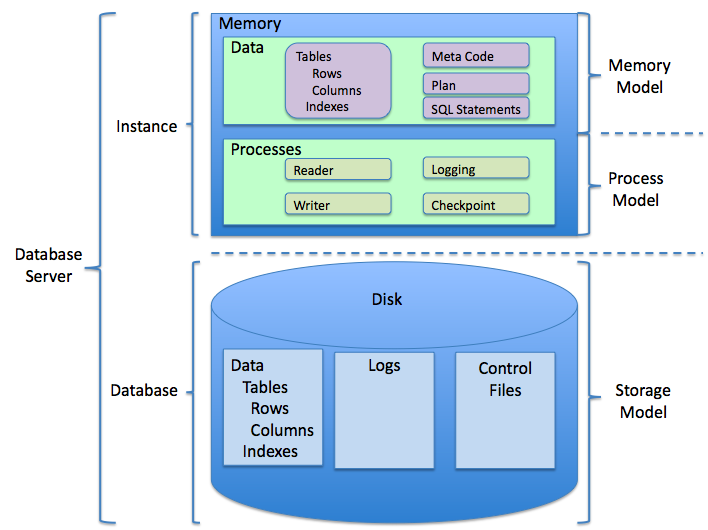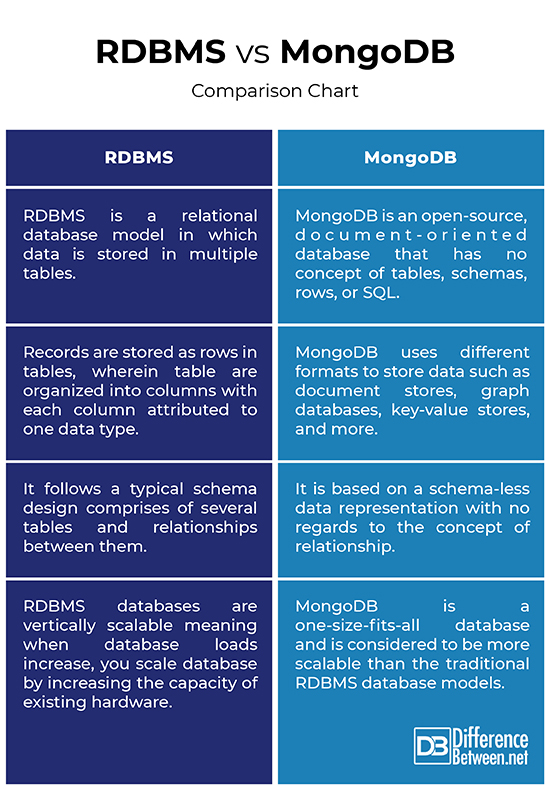Difference Between RDBMS and MongoDB
The Internet is the new frontier of the digital world and today, more than half of the world’s population is online. With billions of people using the Internet, traditional database solutions such as the relational database model have been struggling to meet the constantly changing needs to handle insane amounts of data that is being generated on a second basis. These growing needs gave rise to NoSQL databases which are designed not only to replace SQL databases, but to provide a different perspective in how the data is to be stored.

What is RDBMS?
RDBMS stands for “Relational Database Management System.” An RDBMS is a software program used to create, maintain and administer relational databases. A database is a collection well-organized related data. Examples of databases include employee records, library management system, bus, railway, and airline reservation system. RDBMS is a subset of DBMS with relationship between tables and rows. It follows the relational model instead of navigational model, where in the data is stored in multiple tables. The tables are related to each other using primary and foreign keys. It is the most used database model widely used by enterprises and developers for storing complex and huge amounts of data. The relational model was introduced in 1970 by E.F. Codd and since then, it has been used as a theoretical and practical basis for many studies and investigations.

What is MongoDB?
MongoDB is a document-oriented NoSQL database program that allows data to persist in a nested state and more importantly, it can query that data in an ad hoc fashion. NoSQL is a generic term used to refer to any database schema that does not follow the traditional RDBMS model. MongoDB is an open-source database model with no concept of tables, schemas, rows or SQL. MongoDB is probably a very different database program than what you’ve used before, especially the relational database management system. MongoDB is designed to be flexible, scalable and very fast, even with big loads of data. It is specially built for high availability and supports dynamic, rich schemas, and allows you to distribute data across multiple servers effortlessly. Unlike the RDBMS model, NoSQL databases use entirely different formats such as document stores, graph databases, key-value stores, etc.
Difference between RDBMS and MongoDB
Model
– RDBMS stands for “Relational Database Management System” and it is a relational database model in which data is stored in multiple tables. The database is represented as a collection of relations which are saved in the tabular format, providing access to data points that are related to one another. MongoDB is a relatively new, high-performance database that is a very different database program than the relational database management system. MongoDB is an open-source, document-oriented database that has no concept of tables, schemas, rows, or SQL.
Data Storage
– RDBMS works on relational databases which store data in tables – table are organized into column with each column attributed to one data type. The data for a single instance is stored as a row. MongoDB, on the other hand, is a document-oriented NoSQL database which does not follow the traditional RDBMS model – the data is not related to each other and it does not use SQL as a query language. Unlike RDBMS, they use different formats to store data such as document stores, graph databases, key-value stores, and more.
Schema
– Schema is basically a blueprint of the database which defines how the data is organized and their relations are associated. The traditional RDBMS model contains a schema which is predefined. It follows a typical schema design comprises of several tables and relationships between them. MongoDB, on the other hand, is based on a schema-less data representation with no regards to the concept of relationship. The best thing about the schema-less approach is that you do not need to define a data structure beforehand, which can continue to change over time.
Scalability
– One of the notable differences between RDBMS and MongoDB is that MongoDB is considered to be more scalable than the traditional RDBMS database models. Most NoSQL systems, such as MongoDB have the ability to store your database on multiple machines while still maintaining high-speed performance. It has a built-in support for replication and sharding, and it also supports linear scalability. MongoDB is a one-size-fits-all database, providing solid performance wherever you choose to deploy it. Its modest requirement allow it to run on high-powered servers, virtual machines, or powering cloud-based applications.
RDBMS vs. MongoDB: Comparison Chart

Summary of RDBMS vs. MongoDB
In a nutshell, MongoDB is a one-size-fits-all database based on a schema-less data representation which does not follow the traditional RDBMS model. The data is non-relational and it does not use SQL as a query language. RDBMS is a traditional database model that works on relational databases wherein data is stored in the form of the conventional row-column structure whereas MongoDB is a document-oriented model that has no concept of rows, columns, schemas, or SQL. Ultimately, you must decide what works best for you.
- Difference Between Caucus and Primary - June 18, 2024
- Difference Between PPO and POS - May 30, 2024
- Difference Between RFID and NFC - May 28, 2024
Search DifferenceBetween.net :
Leave a Response
References :
[0]Paredaens, Jan et al. The Structure of the Relational Database Model. Berlin, Germany: Springer, 2012. Print
[1]Sumathi S. and S. Esakkirajan. Fundamentals of Relational Database Management Systems. Berlin, Germany: Springer, 2007. Print
[2]Membrey, Peter et al. The Definitive Guide to MongoDB: The NoSQL Database for Cloud and Desktop Computing. New York, United States: Apress, 2011. Print
[3]Darwen, Hugh. An Introduction to Relational Database Theory. London, United Kingdom: Bookboon, 2009. Print
[4]Marchioni, Francesco. MongoDB for Java Developers. Birmingham, United Kingdom: Packt Publishing, 2015. Print
[5]Dayley, Brad. NoSQL with MongoDB in 24 Hours. Indiana, United States: Sams Publishing, 2014. Print
[6]Image credit: https://commons.wikimedia.org/wiki/File:Connection_to_the_MongoDB_Shell.png
[7]Image credit: https://commons.wikimedia.org/wiki/File:RDBMS_structure.png
